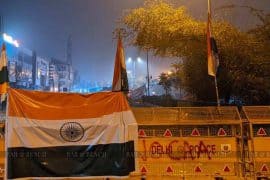We attempt to unearth the history of criminalisation and censorship of women’s bodies.
A bra is one of the many things that societies have imposed upon girls by tricking them into believing they need
it. Reach puberty and a girl’s nipple is perceived to be the most censored object in the universe. Regardless of how blazing the summers are, it’s imperative for the members of the “fairer sex” to cage their breasts. A 15-year study done by Jean-Denis Rouillon, a sports science expert from the University of Besançon, refutes the widely held notion that bras help retain the healthy structure of breasts; another study done by the Department of Gynaecology and Obstetrics, School of Medicine, Brazil found that wearing a bra for several hours is associated with an increased risk of breast cancer. This isn’t a rant against bras (they have their own perks), but against the notion that has made them a sartorial compulsion owing to societal dikkats.
British Brought Blouses
A look at old Indian sculptures or paintings will tell how bras weren’t a part of the Indian culture, our art often
depicts women as topless. Evidence from history suggests that the visibility of the breasts was not equivalent to its
sexualised showcase. But this cannot be used as extended evidence for our progressive nature in the past.
Bandana Tewari, Editor-at-Large of Vogue India, writes, “I think the idea of nudity being sinful came with the Abrahamic religion. Not just in India, but if you look at pre-Abrahamic cultures anywhere in the world, like the Mayan civilization and the Egyptian civilization, bras didn’t exist because the breasts were not seen as objects of titillation. That’s a relatively new phenomenon.”
Brahmins Imposed Nudity
In the book Indian Fashion: Tradition, Innovation, Style, Arti Sandhu wrote that Jnanadanandini Tagore, a social
reformer who invented distinct styles of draping saris, was denied entry to clubs because she covered her breasts
with her saris alone. These facts show how the concept of covering up isn’t as inherently “Indian” as our desi aunties
would like us to believe.
In Southern India, during as early as the 19th century, women from lower castes weren’t allowed to cover their breasts, and to do so they had to pay Mula Karam or breast tax.
In the book Native Life in Travancore, writer Samuel Mateer mentions over a hundred taxes that were levied on the
lower caste population; breast tax was one of them. It was because of Nangeli, an Ezhava woman, whose sacrifice
removed this unjust practice. The folklore around her says that Nangeli covered her blossom and refused to endow the breast tax. When an officer came to her doorstep and demanded the tax, she cut her breasts and gave those to him. She died the same day from her injury, but her act sparked protests that soon led to the removal of Mula Karam.
Today when urban women (most of them upper caste), post topless photos online with populist hashtags like
#FreetheNipple, inspired by a campaign that originated in America, we often conveniently forget how an entire section of women were forcefully kept bare-breasted. The blouse, choli, angadis, or kanchuks weren’t for them. So with this history, one can’t help but feel a sense of irony as urban women of the upper castes denounce their upper garments. Embracing toplessness, thus, suggests an appropriation of DBA women’s lived experiences, and may even be viewed as a negation of their history of oppression.
Reclaiming our Anatomy from Hypocrisy
According to Lina Esco, Director of Free the Nipple, the topfreedom “highlights the general convention of allowing
men to appear topless in public while considering it sexual or indecent for women to do the same and asserts that
this difference is the unjust treatment of women. The campaign argues that it should be legally and culturally
acceptable for women to bare their nipples in public.”
Women’s bodies are sexualised all around us. Censorship regulators are fine with airing hate speeches, gruesome murders, and films that objectify women, but the moment a nipple from the female body comes into frame, screens go black. The feminists aren’t demanding billboards of topless girls to be plastered everywhere, but they are seeking to absolve the taboo attached to female nipples. This taboo further translates to girls being conscious and ashamed of their bodies, and promotes needless censorship.
Adam Lavine’s bare-chested performance at the Super Bowl halftime this February brought back the memory of the Super Bowl halftime of 2004. Named as the infamous “Nipplegate”, it referred to the performance where Janet Jackson’s breast was exposed by Justin Timberlake due to a wardrobe malfunction. Following the incident, Janet was heavily shamed for a nip-slip that wasn’t her fault. Jackson’s singles and music videos were banned by Viacom, MTV, and Infinity Broadcasting. This was a major backseat for her career. Even after giving lengthy explanations and apologies, she continued to be boycotted. At the same time Justin Timberlake went on to have his career and could afford to even joke about the incident. If this isn’t unfairness, then a rational mind wouldn’t know what is.
The feminist battle cries of “burn the bras” might seem very first-worldish and unrelatable in a county like India,
but the effect of these fights will be seen years from now when things like breastfeeding in public, or enjoying the
rain without fearing a translucent t-shirt are normalised.
Feature Image Credits: Katie Vijos
Niharika Dabral
[email protected]




Comments are closed.